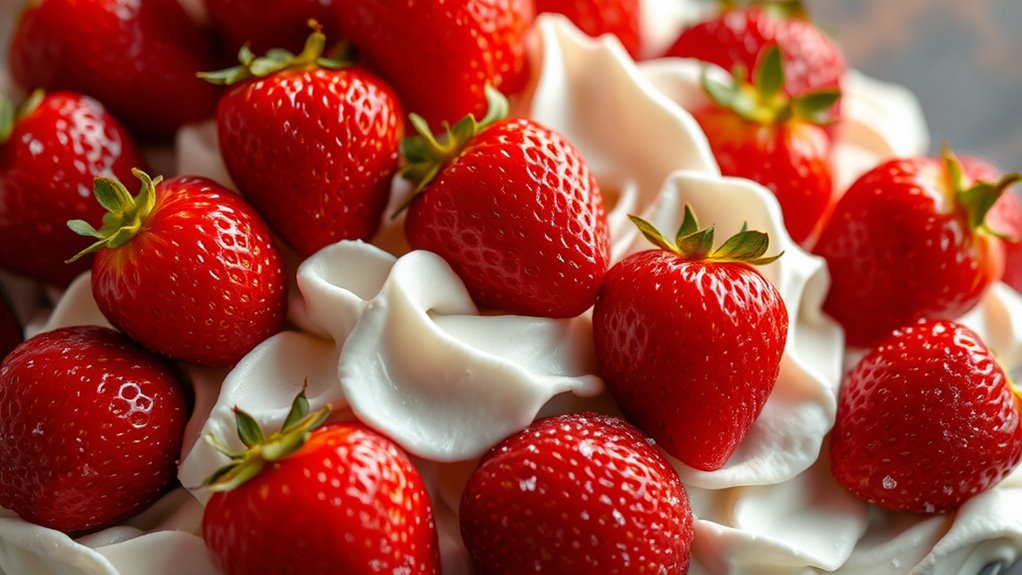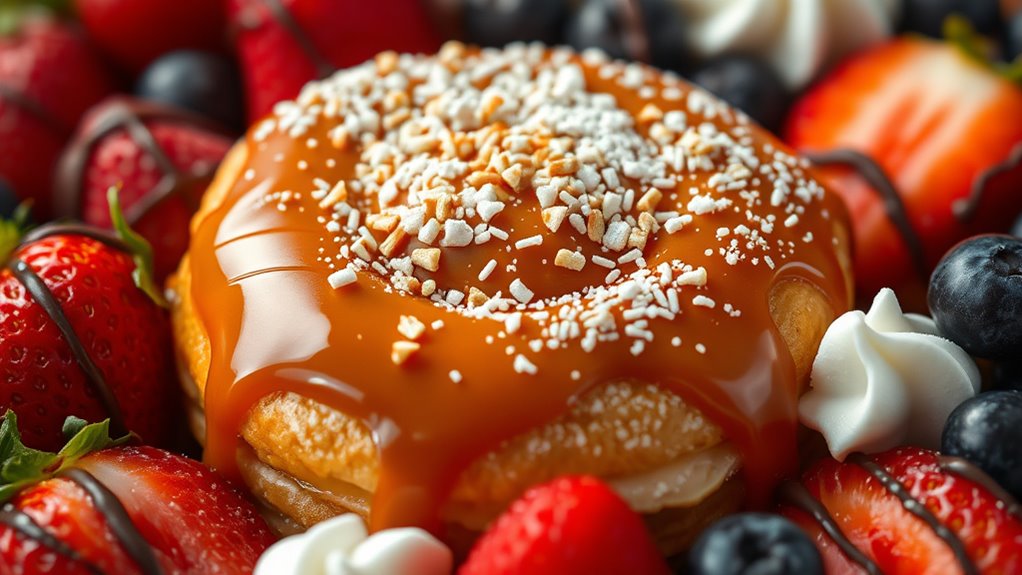Your craving for sweets comes from your brain’s response to sugar’s chemical signals and ancient survival instincts. When you eat sugary foods, your brain releases dopamine, making you feel pleasure and reinforcing the desire for more. Blood sugar spikes and crashes also lead to energy dips, prompting further cravings. Plus, your evolutionary past favors sweet flavors as quick energy sources. To understand these complex triggers better, continue exploring how biology and psychology influence your sweet tooth.
Key Takeaways
- Sugary treats trigger dopamine release, reinforcing pleasure and creating cravings through the brain’s reward system.
- Fast blood sugar spikes and crashes lead to energy fluctuations, prompting further sweet consumption.
- Evolutionarily, humans developed a preference for sweet flavors as signals of high-energy foods like fruit and honey.
- Environmental cues and emotional states, such as stress or boredom, can intensify cravings for sweets.
- Understanding the biological and psychological factors helps develop strategies to manage and reduce sugar cravings.

Craving sweets is a common experience that many people struggle to manage. You might find yourself reaching for chocolate or candies even when you’re not hungry, driven by an inexplicable urge. This desire isn’t just about taste; it’s deeply rooted in your brain’s chemistry and evolutionary biology.
Craving sweets is driven by brain chemistry and evolutionary instincts, not just taste.
When you indulge in sugary treats, your brain releases chemicals like dopamine, a neurotransmitter responsible for pleasure and reward. This creates a cycle where your brain begins to associate sweets with feelings of happiness and comfort, making you crave them more over time.
Your body’s response to sugar is pretty powerful. When you consume sugar, your blood glucose levels spike, providing a quick source of energy. In response, your pancreas releases insulin to help your cells absorb the sugar. But this rapid rise and fall in blood sugar can trigger feelings of fatigue or irritability, which often leads you to seek out more sweets to regain that initial energy boost.
This cycle of highs and crashes creates a strong psychological and physical craving for sugar, especially during times of stress, fatigue, or emotional discomfort.
Evolution plays a significant role in why you crave sweets. Thousands of years ago, when food was scarce, humans developed a preference for sweet flavors because they signaled a high-energy food source—fruit or honey—that was essential for survival.
This preference was advantageous in prehistoric times, but in today’s world of readily available processed sugars, it often leads to overconsumption. Your brain continues to seek out these quick energy sources because it’s wired to do so, even if your body no longer needs the immediate fuel.
Additionally, your environment influences these cravings. If you’re surrounded by tempting desserts and sugary snacks, your brain’s reward system becomes even more responsive.
Emotional factors like stress or boredom can also amplify your desire for sweets, as sugar temporarily stimulates the release of serotonin, a neurotransmitter that boosts mood and provides a sense of calm.
That’s why during stressful days or emotional lows, you might find yourself craving comfort in a sweet treat more than ever.
Understanding the science behind your sweet cravings can empower you to make better choices. Recognizing that these urges aren’t simply about willpower but are also driven by biology and psychology helps you approach cravings with compassion and strategies.
By being aware of how environmental cues can trigger cravings, you can better prepare to resist temptation and develop healthier habits.
Whether it’s choosing healthier alternatives, managing stress, or regulating blood sugar levels through balanced meals, knowing the science gives you the tools to break free from the cycle of sugar cravings and develop a healthier relationship with sweets.
Frequently Asked Questions
Can Genetics Influence Our Sweet Cravings?
Genetics can influence your sweet cravings by affecting how your brain responds to sugar. If you have certain genes, you might experience stronger urges for sweets because your body reacts more intensely to sugar’s pleasurable effects.
You may also have a predisposition for higher dopamine release, which reinforces the craving. So, your genetic makeup plays a role in shaping your desire for desserts, making some cravings more intense than others.
How Does Sugar Affect Brain Chemistry Long-Term?
Imagine your brain as a lush garden, where sugar acts like a mischievous gardener.
Long-term, excess sugar floods your brain with dopamine, creating a cycle that encourages cravings and diminishes your natural ability to enjoy less sweet foods.
Over time, this can weaken your mental resilience, making it harder to resist sweets.
Do Cultural Factors Impact Dessert Preferences?
You’re influenced by cultural factors that shape your dessert preferences in many ways. Your upbringing, traditions, and social environment expose you to specific flavors and types of sweets, making them more appealing.
Over time, these cultural experiences become ingrained, guiding your choices and cravings. So, your dessert preferences aren’t just about taste—they also reflect your cultural background, creating a unique connection between your identity and the sweets you enjoy.
Are There Health Risks Associated With Excessive Sweet Consumption?
While enjoying sweets can be delightful, overdoing it poses health risks you mightn’t realize. Excessive sugar intake increases your chances of obesity, type 2 diabetes, and heart disease.
You might think occasional treats are harmless, but consistently high consumption taxes your body. To stay healthier, balance your diet with fruits and whole foods, and savor desserts in moderation.
This way, you enjoy sweets without risking your well-being.
Can Mindful Eating Reduce Sugar Cravings Effectively?
You might wonder if mindful eating can cut your sugar cravings. It definitely can help; by paying close attention to how you feel and savoring each bite, you increase your awareness of true hunger versus emotional eating.
This practice allows you to enjoy treats in moderation and reduces impulsive snacking. Over time, mindful eating can rewire your habits, making you more conscious of your sugar intake and less likely to crave sweets unnecessarily.
Conclusion
Understanding why you crave sweets is like opening a secret garden inside your mind. Your brain seeks comfort and quick energy, turning to sugar as a familiar, sweet escape. By recognizing these cravings, you hold the key to healthier choices. Remember, breaking free from the sugar vine isn’t about deprivation but finding balance. With awareness, you can tame your sweet tooth and enjoy life’s desserts without losing your way in the jungle of cravings.









